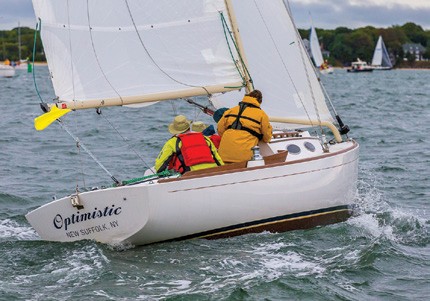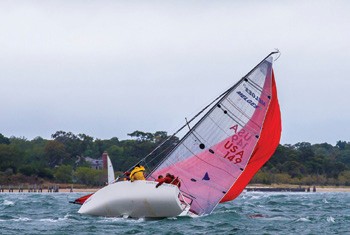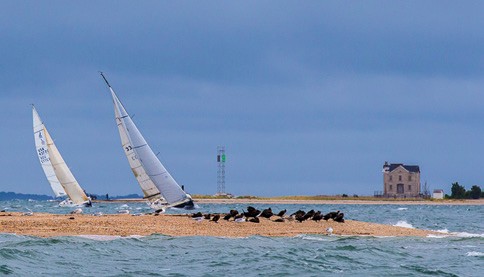By Andrew Shemella
 I’ve written in these pages and elsewhere about my disdain for the waters around the MO-A buoy off Greenport, NY in Gardiner’s Bay. Now I have company. Bill Archer and his three crew found themselves suddenly in those waters as their Alerion Express 28 Optimistic sank while competing in the Peconic Bay Sailing Association’s Whitebread XXI ‘Round the Whirl Regatta on Saturday, October 4, 2014.
I’ve written in these pages and elsewhere about my disdain for the waters around the MO-A buoy off Greenport, NY in Gardiner’s Bay. Now I have company. Bill Archer and his three crew found themselves suddenly in those waters as their Alerion Express 28 Optimistic sank while competing in the Peconic Bay Sailing Association’s Whitebread XXI ‘Round the Whirl Regatta on Saturday, October 4, 2014.
Bill Archer’s Optimistic before “The Incident” © RJ LaBella/RJLaBellaPhotos.com
We were on Zeus, a J/34C owned by Chip Puccio, about 1/4 mile away when one of our crew shouted above the 25- to 30-knot wind that some boat had suffered a major knockdown…and then immediately updated us that it was going down. I was facing the other way on the rail, and by the time I looked all I could see of the stricken boat was the bow pointing grotesquely up in the air and the sail completely in the water. The next time I looked it was gone. If the whole sinking took a minute I would be surprised. There were four heads in the water but on our port tack, with steep four-foot waves raking the rail I was hard pressed to get much of a look. The crew who announced the knockdown immediately found the VHF and called in a Mayday.
As we drew closer, other nearby contestants had lowered their sails and were rendering assistance. We later learned that the knockdown caused a lot of water to enter Optimistic’s large cockpit, and the next waves finished them off. Bill later told us the scariest part was the sound of the air hissing out of the bow as the boat sank. For us on Zeus, the scene was surreal as we tried to process the suddenness of the sinking. The boat was quiet as we contemplated the potential unfolding tragedy taking place nearby. We didn’t know which boat it was, if everyone got out or if the assisting boats could get the victims out of the water. They did. But it was a struggle as the victims became tired very quickly. And, none of those crews had been thinking about a rescue even five minutes earlier. I think everyone was out of the water in 15 minutes, so good on Mahlon Russell and Bob McIlvain for their quick action.
Last year’s Whitebread XX and this year’s XXI were both sailed in strong winds that have erased sailors’ memories of the drifters we endured. This year’s rendition started in the predicted 15- to 20-knot southeast breeze that was expected to gust into the low thirties. The designated course was designated “C,” a counterclockwise circumnavigation of Shelter Island, including my adversary the MO-A buoy. We would enjoy an outgoing tide for the trip out and some incoming on the way back; the later boat divisions would enjoy more incoming.
 Back on Zeus we rounded first mark, the R20 buoy off Nassau Point, ending a short upwind leg after the start, and pointed the bow northeast into the southeast breeze. In other words, a nice reach. The game was to stay close to the layline, in as much current as could be found and keep your air clear. In pursuit of the latter we had to throw in some evasive maneuvers, the “tactical roundup” which served to get us above boats which were in our air. We wanted to avoid the destructive luffing contests which can be deadly in
Back on Zeus we rounded first mark, the R20 buoy off Nassau Point, ending a short upwind leg after the start, and pointed the bow northeast into the southeast breeze. In other words, a nice reach. The game was to stay close to the layline, in as much current as could be found and keep your air clear. In pursuit of the latter we had to throw in some evasive maneuvers, the “tactical roundup” which served to get us above boats which were in our air. We wanted to avoid the destructive luffing contests which can be deadly in
A memorable moment for the crew of Michael Bartolotta’s Melges 24 PB&J © RJ LaBella/RJLaBellaPhotos.com
timed competition.
We found ourselves in the company of Bill Rich’s Fishers Island 31 Spindrift, a familiar situation for me this summer. Just behind us was Mike Canuso’s J105 Live Wire, also familiar since I had driven her in two races this season. Ahead of us was Andrew Baris’ Sabre 402 Impulse. We weren’t racing any of these yachts for a trophy, so were content to have Impulse pull slowly away. At least that boat would not be a speed governor for us. We out legged Spindrift and waved the 105 by. So we had clear air as we reached up Little Peconic Bay as the gusty wind reached its predicted state. We just needed to avoid the big mistake. So, there was the usually second-guessing about the course when divisions ahead weren’t sailing where we thought they should. But a quick check of the SIs resolved that.
We were flushed through Greenport Harbor on the strong outgoing current. Soon it was time to think about the upcoming leg which would be on the wind from the breakwater to that buoy despised by me, MO-A. The gusts in the lee of Shelter Island were impressive, and none of us thought it was going to be anything but a rough slog. From my position on the rail, the word “Reef” wafted forward. Excellent idea! And, most of the contestants nearby were shortening sail. Jeff Barnett’s Hobie 33 Between the Sheets sailed nude of a headsail for several minutes while changing headsails. And Impulse had put in a mainsail reef and later rolled up a bit of jib. We were all on the same page. Within a very short time, we had the reef tied in the main and the flatness of that sail gave us confidence for the upcoming slog.
Soon enough we were sailing through, or sometimes slamming over, the four-foot waves and I was getting green water coming down the rail. The tide was still rushing out and, against the southeasterly wind, was creating steep seas. Did I mention the rain? So dry wasn’t an option, but my Gill gear was performing well and I wasn’t cold as I clung to the deck when it seemed the waves could wash me off. The Y flag was flying at the start and we all were wearing jackets. The seawater was warm and salty, and the rain cold and sweet. That was probably an example of a distinction without a difference. I was getting wet. But I was having a grand time and we were doing well until “The Incident.”
After rounding MO-A, we were increasingly heading away from the wind, which was around 30 knots gusting to the mid 30s. It was fine sailing that was marred by “The Incident.” The boat was quiet. Our gestalt improved when we learned over the VHF that the rescues were successful. We then knew which boat sank and that everyone was safe. We know the skipper and some of the crew. They are our sailing mates, friends, neighbors, fathers, wives…you get the picture. The relief was palpable.
Banter returned to the boat. We were still a very manageable distance behind Impulse. Spindrift was still there but not a threat to our clear air, and that was all we needed from them. We had sailed all day basically between the same two boats we were on the leg up Little Peconic Bay with them. Now, sailing down the same bay, we were being passed by the fastest boats in the fleet. As far as our encounters with them, the faster the better! It wasn’t bad to see a trimaran blast by us – to leeward – while we fumbled with our cell phones to get a picture. The wake off the leeward hull looked like a log flume. As we neared the last leg we were pretty confident that none of our class were ahead, so it would be a time game. You never know about the competition behind. We enjoyed getting the gun and learned at the awards that we took first place.
The after-race party featured endless stories of the day’s adventure, tempered a bit by “The Incident.” But the skipper of the stricken boat and his wife were dancing with the rest of us, to the music of the Loan Sharks, as sailors celebrated a great day of sailing. The crowd seemed all the more lively and engaged in living having walked the line between adventure and danger. It is a gossamer line. Visit pbsa.us for more information.


 John Sommi’s J/88 Cloud 9 and Mike Canuso’s J105 Live Wire on their way around Shelter Island © RJ LaBella/
John Sommi’s J/88 Cloud 9 and Mike Canuso’s J105 Live Wire on their way around Shelter Island © RJ LaBella/

